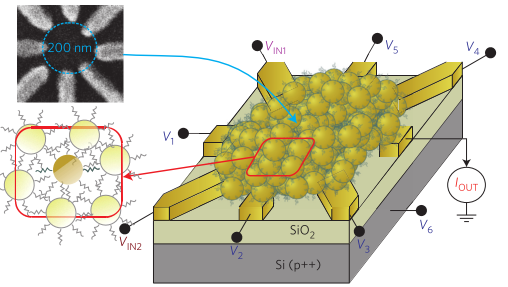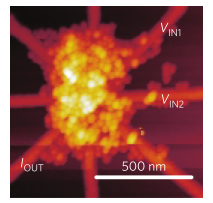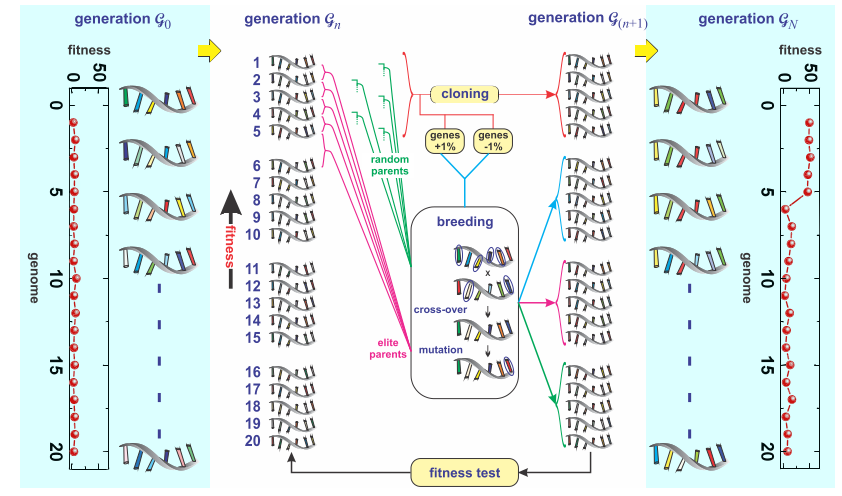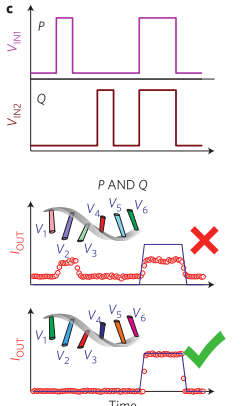Is it possible to program an unstructured object?
Researchers from the University of Twente in Enschede, the Netherlands (University of Twente, Enschede), asked themselves a question: is it possible to program some shapeless nanoscale object to perform mathematical operations?
A blob (blob) from gold nanoparticles 20 nm in diameter, placed on 8 gold electrodes by dielectrophoresis, was chosen as such an object.


The nanoparticles have a diameter of 20 nm and are coated with non-conducting 1-octanethiol (C 8 H 17 SH), which creates a gap between adjacent nanoparticles of about 1.8 nm. At temperatures near absolute zero, electrical transport through such a network of nanoparticles is completely determined by a Coulomb blockade , and each nanoparticle acts as a single-electron transistor ( single-electron transistor , SET). In this paper, the system operated at a temperature of 0.3 K.
So, this shapeless mass of nanoparticles was placed on 8 radially directed electrodes, the distance between which was 200 nm. Of these eight electrodes, 2 were randomly selected as inputs, one as output, and the five remaining plus substrates as 6 control gates, to which a constant voltage was applied.
The first goal pursued by researchers was the implementation of a logical I operation in this system. Direct brute force on 6 closures would take an impressive amount of time (estimated to be about days). And even a gradient descent in such a 6-dimensional space would be inefficient due to the strong non-linearity of the system and the presence of a large number of local minima.
It was decided to apply a genetic algorithm to search for the required configuration of valves.

6 control voltages applied to the gates were considered as a “genome”. Initially, 20 genomes were randomly generated. Further, for each of the genomes, the inputs (P, Q) were given signals of the Boolean type 0-1-0-1 and 0-0-1-1, and the output signal was compared with the desired function (P · Q).

Thus, for each of the six constant stresses (genomes) supplied to the gates, “fitness” (fitness) was determined. The 20 genomes were then sorted according to their fitness, of which 5 were selected with the best indicators. Using these 5 parental genomes, the first generation of subsidiaries was formed, using cloning (in other words, direct copying), mutations (± 1% small changes in the signals) and crossing. For the obtained 20 daughter genomes, the same steps are repeated: measuring the output signal, calculating fitness, sorting, and selecting the best ones. Using this algorithm, the scientists managed to program their shapeless “device” to perform the Boolean functions of two variables, and on the same sample.

The following properties were shown separately:
a) independence from previous conditions: the found genome for AND gate works correctly for random signals at the input;
b) temperature stability: the genome remains working when the system is heated up to 15K, followed by cooling to temperatures below 5K. When heated above 15K, reprogramming is required;
c) time stability: after 100 hours, the programmed device does not lose its properties.

')
In this paper, the algorithm converged to the required function in ~ 200 steps, which took about 1 hour, since relatively slow signals were used at the input. However, researchers believe that it is possible to accelerate the operation of the system 100-1000 times by optimizing it. In addition, using smaller nanoparticles, for which the Coulomb interaction will be much more significant, we can expect the operation of such a system at significantly higher temperatures down to room temperature.
Thus, the use of a genetic algorithm at the nanoscale level makes it possible to compensate for variations from instrument to instrument and performance uncertainties that are inevitable miniaturization satellites.
PS Thank you Tiberius for inspiration.
Source: Bose, SK et al. Evolution of a designless nanoparticle network into reconfigurable Boolean logic. Nat. Nanotechnol. 10 , 1048-1052 (2015). doi: 10.1038 / nnano.2015.207
A blob (blob) from gold nanoparticles 20 nm in diameter, placed on 8 gold electrodes by dielectrophoresis, was chosen as such an object.
The nanoparticles have a diameter of 20 nm and are coated with non-conducting 1-octanethiol (C 8 H 17 SH), which creates a gap between adjacent nanoparticles of about 1.8 nm. At temperatures near absolute zero, electrical transport through such a network of nanoparticles is completely determined by a Coulomb blockade , and each nanoparticle acts as a single-electron transistor ( single-electron transistor , SET). In this paper, the system operated at a temperature of 0.3 K.
So, this shapeless mass of nanoparticles was placed on 8 radially directed electrodes, the distance between which was 200 nm. Of these eight electrodes, 2 were randomly selected as inputs, one as output, and the five remaining plus substrates as 6 control gates, to which a constant voltage was applied.
The first goal pursued by researchers was the implementation of a logical I operation in this system. Direct brute force on 6 closures would take an impressive amount of time (estimated to be about days). And even a gradient descent in such a 6-dimensional space would be inefficient due to the strong non-linearity of the system and the presence of a large number of local minima.
It was decided to apply a genetic algorithm to search for the required configuration of valves.
6 control voltages applied to the gates were considered as a “genome”. Initially, 20 genomes were randomly generated. Further, for each of the genomes, the inputs (P, Q) were given signals of the Boolean type 0-1-0-1 and 0-0-1-1, and the output signal was compared with the desired function (P · Q).
Thus, for each of the six constant stresses (genomes) supplied to the gates, “fitness” (fitness) was determined. The 20 genomes were then sorted according to their fitness, of which 5 were selected with the best indicators. Using these 5 parental genomes, the first generation of subsidiaries was formed, using cloning (in other words, direct copying), mutations (± 1% small changes in the signals) and crossing. For the obtained 20 daughter genomes, the same steps are repeated: measuring the output signal, calculating fitness, sorting, and selecting the best ones. Using this algorithm, the scientists managed to program their shapeless “device” to perform the Boolean functions of two variables, and on the same sample.
The following properties were shown separately:
a) independence from previous conditions: the found genome for AND gate works correctly for random signals at the input;
b) temperature stability: the genome remains working when the system is heated up to 15K, followed by cooling to temperatures below 5K. When heated above 15K, reprogramming is required;
c) time stability: after 100 hours, the programmed device does not lose its properties.
')
In this paper, the algorithm converged to the required function in ~ 200 steps, which took about 1 hour, since relatively slow signals were used at the input. However, researchers believe that it is possible to accelerate the operation of the system 100-1000 times by optimizing it. In addition, using smaller nanoparticles, for which the Coulomb interaction will be much more significant, we can expect the operation of such a system at significantly higher temperatures down to room temperature.
Thus, the use of a genetic algorithm at the nanoscale level makes it possible to compensate for variations from instrument to instrument and performance uncertainties that are inevitable miniaturization satellites.
PS Thank you Tiberius for inspiration.
Source: Bose, SK et al. Evolution of a designless nanoparticle network into reconfigurable Boolean logic. Nat. Nanotechnol. 10 , 1048-1052 (2015). doi: 10.1038 / nnano.2015.207
Source: https://habr.com/ru/post/395395/
All Articles